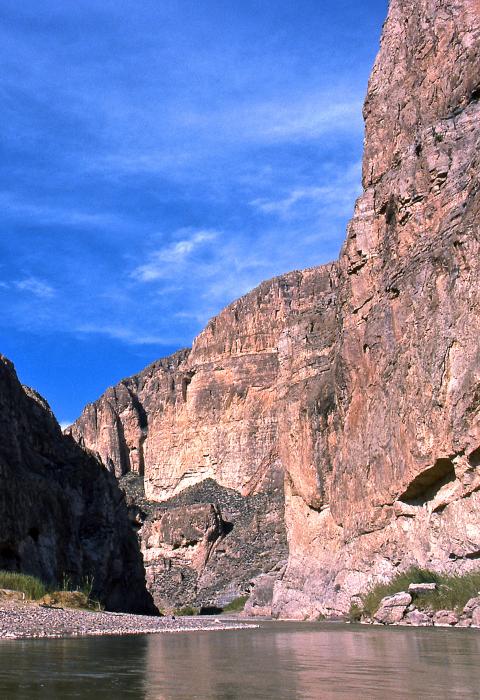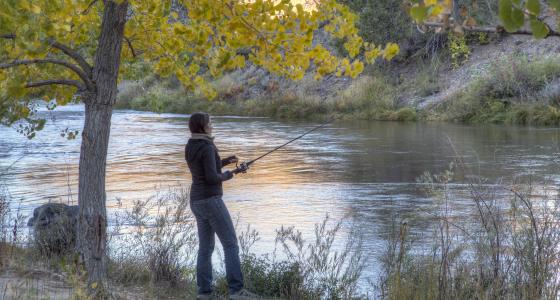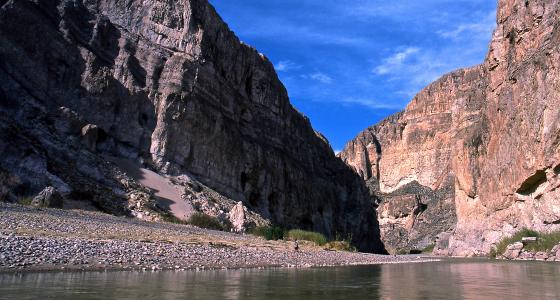Rio Grande
Rio Grande
Texas
This 191-mile stretch of the United States side of the Rio Grande along the Mexican border begins in Big Bend National Park. The NPS’s jurisdiction on the Rio Grande downstream from the Big Bend National Park’s boundary includes only the river area from the United States/Mexico international boundary in the middle of the deepest channel to the gradient boundary at the edge of the river on the United States’ side. The river cuts through isolated, rugged canyons and the Chihuahuan Desert as it flows through some of the most critical wildlife habitat in the country.
Designated Reach
November 10, 1978. The segment on the United States side of the river from river mile 842.3 above Mariscal Canyon downstream to river mile 651.1 at the Terrell-Val Verde County line.
Outstandingly Remarkable Values
Botany
The unique biological characteristics of the Rio Grande result from a mosaic of high-gradient flows through narrow, steep-walled canyons to slow-moving waters that meander through wide alluvial channels. These varied river environments are further punctuated by small patches of refugia, including run and riffle environments near tributary mouths, backwater wetlands in abandoned river channels and floodplain springs, and spring inputs that provide high-quality water and more reliable flows. Remnant cottonwood stands and other imperiled riparian plant communities are also present, but faced with the harmful effects of highly invasive, nonnative tamarisk and giant cane. The wild and scenic river corridor supports at least 38 native plant species that are considered rare. Thirty are listed by Texas Parks and Wildlife as “species of greatest conservation need”—2 “critically imperiled”species, 2 “critically imperiled” varieties, 14 “imperiled” species, and 16 “vulnerable” species.
Culture
Although the first Europeans considered the land el despoblado, “the uninhabited land,” humans have lived along the river for at least twelve millennia. Prehistoric sites reflect the adaptation to diminishing water resources across the landscape and increased reliance on the river and its tributaries for sustenance. The presence of Europeans in the Big Bend region is marked by sites from Hispanic contact (i.e., Spanish conquest and establishment of missions, ranches, and farms), and Anglo settlement (i.e., military, mining, ranching and farming, commerce, resource exploitation, and modern recreation).
Four sites in the wild and scenic river corridor are listed on the National Register of Historic Places. These include Sublett Farm Historic District, Castolon Historic District, the Hot Springs Historic Site, and the John Daniels Farm Historic Site.
Fish
The wild and scenic river supports 40 native fish species of which 17 are listed as species of concern—the majority of which are found only in this area. These include the recently reintroduced federally listed Rio Grande silvery minnow. Other threatened and endangered fish species include the Chihuahua shiner, Rio Grande shiner, Mexican stoneroller, speckled chub, long-nosed dace, round-nosed minnow, Rio Grande blue catfish, Big Bend Gambusia, and Rio Grande blue sucker. Found nowhere else, the wild and scenic river is the last refuge for the Rio Grande blue sucker.
Geology
The Rio Grande is highly unusual in the region because it flows through portions of two major geologic provinces—Basin and Range and Interior Plains. It also traverses the Basin and Range, Laramide, and Edwards Plateau geologic areas. The river cuts through highlands created by continental extension in three separate events, the Laramide Orogeny, the Basin and Range followed by the Rio Grande Rift. Deep canyons expose 100 million years of geologic history along the river, including one of the largest and most accessible continuous exposures of Cretaceous strata in Texas.
The Rio Grande provides a rare opportunity to see textbook examples of many geologic features, including dramatic faulting, folding, and igneous sills. Diverse erosional and solutional features are also visible, such as arches, hoodoos, spires, pinnacles, caves, mass wasting, and rock shelters.
Recreation
The Rio Grande provides a variety of recreational opportunities that allow visitors to experience a spectacular river corridor as it carves its way through the Chihuahuan Desert. Colorful, expansive landscapes give way to vault-like canyons that carry travelers through time and space, providing world-class year-around boating, hiking, camping, wildlife viewing, photography, and natural springs. Visitors can enjoy and experience rare desert flora and fauna, solitude, natural sounds, and amazing night skies in a remote and dramatic landscape that is largely wild and undeveloped.
Scenery
The Rio Grande and its tributaries are set within one of the most dramatic and storied landscapes in the West—from stunning narrow and deep canyons, verdant riparian vegetation, and striking cliffs—to long and unobstructed views. Sheer cliffs define the landscape where exceptionally rugged canyons meet the sky with unparalleled beauty and the unsurpassed ability to inspire and impress. Exposures of geologic processes are on display throughout the river course as Cretaceous features express themselves as uplifts, faults, rapids, and spectacular formations. The dynamic history and culture of the region also becomes apparent as ruins and evidence of those who came before dot the landscape.
Wildlife
As the only major river system in the Chihuahuan Desert, the dynamic and varied aquatic and riparian environments of the Rio Grande serve as the lifeblood for numerous threatened mussels, reptiles, amphibians, birds, mammals, and insects. Rare mammals that inhabit the river corridor include the Mexicanus subspecies of Mexican beaver, coatimundi, and the western mastiff bat. Rare herpafauna include the Big Bend slider. Rare peregrine falcons, Mexican black hawks, grey hawks, and yellow-billed cuckoos are also present. Other rare aquatic species include a variety of native freshwater unionid (mussel and clam) species such as the Texas hornshell, Salina mucket, Tampico pearlymussel, and fingernail clam. Rare aquatic insects include Stictotarsus neomexicanus (a threatened diving beetle), Argia rhoadsi (the northernmost extent of this damselfly species), and Thermo spheroma (a rare endemic isopod unique to hot springs found along the river).



